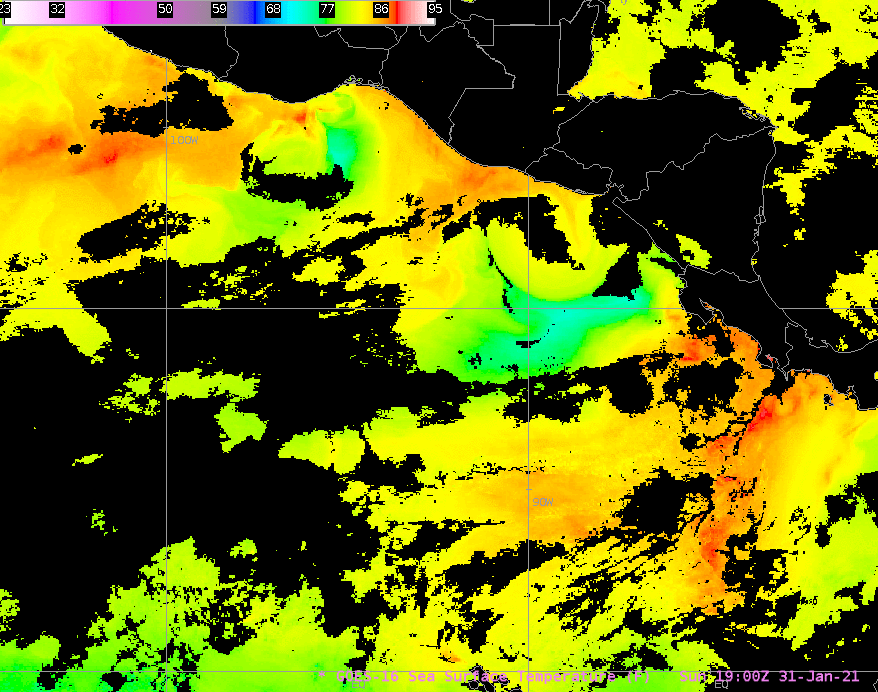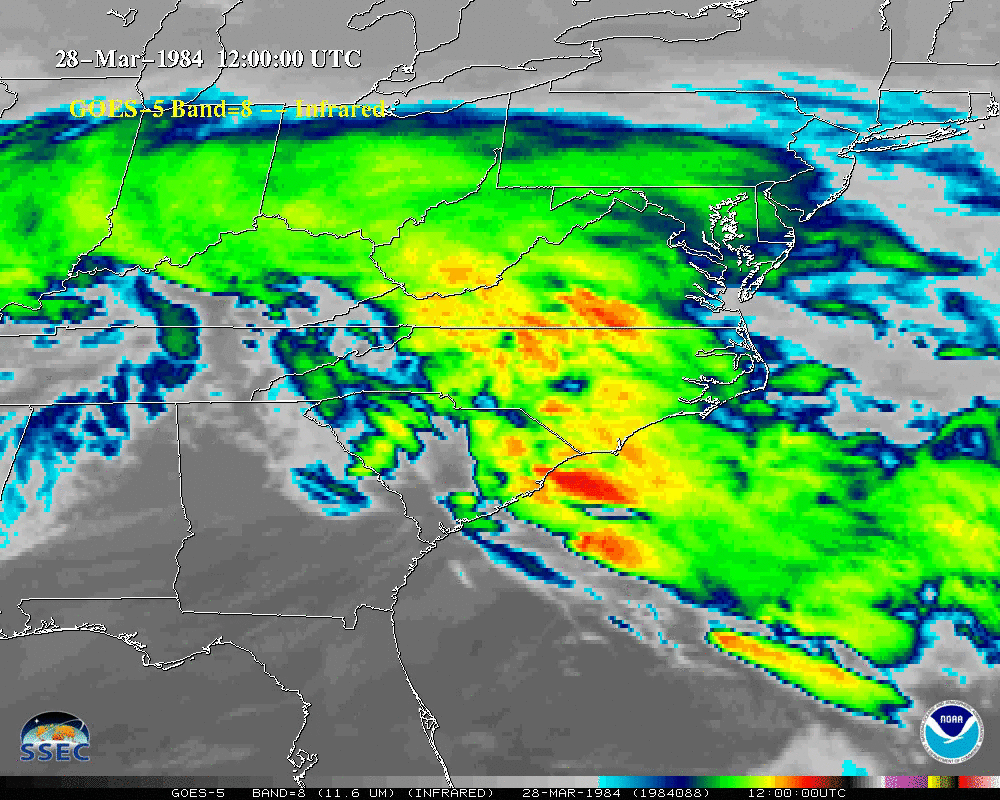
[ Archive ]

 |
CIMSS-NOAA Weekly Report [ Archive ] |
 |
CIMSS AND ASPB WEEKLY HIGHLIGHTS FOR THE WEEK ENDING APRIL 2, 2021
PRODUCTS AND APPLICATIONS:
AWARDS AND RECOGNITION:
PUBLICATIONS:
Manuscript publised on the application of GOES-16 brightness temperatures for high-resolution model validation: A manuscript entitled “Evaluating Convective Initiation in High-Resolution Numerical Weather Prediction Models Using GOES-16 Infrared Brightness Temperatures” by David Henderson (SSEC) et al. was published in the March issue of the Monthly Weather Review along with co-authors Jason Otkin (CIMSS) and John Mecikalski (University of Alabama-Huntsville). The paper applies object-based cloud verification using 5-min GOES-16 imagery to evaluate the evolution of heavily precipitating convection from high-resolution (500 m) model simulations. The combined model-observational platform demonstrated that differences in the timing of rainfall formation impacts the amount of ice reaching the upper portion of the cloud -- upper-cloud ice formation was a main factor in determining if convection was more likely to become a long-lived thunderstorm. (https://doi.org/10.1175/MWR-D-20-0272.1) (J. Otkin, CIMSS, 608-265-2476)
WORKSHOPS, CONFERENCES, AND MEETINGS:
Tenth Session of the WMO Panel on Polar and High Mountain Observations, Research, and Services: The 10th meeting of the World Meteorological Organization's (WMO) Executive Council Panel of Experts on Polar and High Mountain Observations, Research, and Services (EC-PHORS) was held virtually 29-31 March 2021. The Panel provides guidance in the development of the WMO Strategic Plan, facilitates the acquisition, exchange, and archiving of observational data, and makes recommendations on research and operations related to the polar regions. Jeff Key, one of the US representatives on the panel, presented the history of, and need for, the Polar Space Task Group (PSTG), on which he is the Vice Chair. He also worked with the WMO Secretariat on a number of the meeting documents such as the new EC-PHORS terms of reference and the Global Cryosphere Watch (GCW) pre-operational plan. This meeting was particularly important given the major restructuring that WMO is currently undertaking and its impact on GCW, PSTG, and EC-PHORS. Other US participants included Scott Lindsey (NWS Alaska), Alexandra Isern (NSF), Aimee Devaris (USGS Alaska), and Shanna Combley (NWS International Affairs). Meeting information and documents are available at https://bit.ly/3sIkxeO. (J. Key, E/RA2, 608-263-2605, jeff.key@noaa.gov)
ISCC-7: Hank Revercomb and Paul Menzel attended the Seventh International Strategic Consultative Committee (ISCC-7) Virtual Meeting that took place 25-26 March and 1 April 2021. ISCC-7 consisted of 14 international experts and 25 experts from China that reviewed China’s satellite plans through 2035 for conformance with the space component of the WMO (World Meteorological Organization) Integrated Global Observing System (WIGOS). Of note were the following: (1) China celebrated 50 years of FengYun satellites in October 2020. (2) The China Meteorological Administration (CMA) will launch their second geostationary (geo) IR hyperspectral sounder (Geostationary Interferometric Infrared Sounder - GIIRS) on FY-4B in June 2021. (3) FY-4M plans to introduce a geo microwave capability in 2025. (4) Long-term low earth orbiting (leo) plans include satellites in 4 orbits – am, pm, early morning to be started with FY-3E in 2021, and low inclination. (5) The new leo FY-5 series is slated to start in 2028 and the new geo FY-6 series before 2035. (6) CMA is planning in orbit reference sensors in leo with FY-5 LIBRA for later this decade. (W.P. Menzel, CIMSS, 608-263-4930)
Annual NOAA Regional Collaboration Network Meeting: The STAR Advanced Satellite Products Branch (ASPB) was represented at the 2021 NOAA Regional Collaboration Network (RCN) Workshop held virtually 23-25 March 2021. Mark Kulie (ASPB) attended the workshop as a member of the NOAA Great Lakes Regional Collaboration Team delegation. Workshop attendees learned about collaborative work being performed within various RCN's across the country, received training on developing more effective leadership and communication skills, learned about a diverse spectrum of innovative artificial intelligence projects being conducted across different NOAA line offices, and strategized about adopting best practices for customer engagement. (M. Kulie, E/RA2, 608-263-6583, mark.kulie@noaa.gov)
Virtual Presentation for NCU in Taiwan: Cooperative Institute for Meteorological Satellite Studies (CIMSS) scientist/researcher Tim Olander remotely gave an invited presentation to the National Central University (NCU) in Taiwan in their Meteorological & Environmental Remote Sensing Virtual Online Seminar series. The presentation covered various tropical cyclone intensity estimation algorithms developed by the CIMSS Tropical Cyclone group, including the established Advanced Dvorak Technique (ADT) and Satellite Consensus (SATCON) algorithms, as well as the experimental "AI-enhanced" ADT (AiDT). (T. Olander, CIMSS, 608-265-8005)
TRAINING AND EDUCATION:
MEDIA AND OUTREACH:
CIMSS Scientist Interviewed About ABI Fire Detection: On March 29, 2021 Nathan Santo Domingo, the meteorologist for Iowa's News Now out of Cedar Rapids, Iowa, interviewed Chris Schmidt of the Cooperative Institute for Meteorological Satellite Studies (CIMSS) on the subject of monitoring wildfires with the Geostationary Operational Environmental Satellite (GOES) Advanced Baseline Imager (ABI). Eastern Iowa can be prone to rapidly spreading grass fires at this time of year, as was the case west of Cedar Rapids that very evening. Nathan Santo Domingo regularly makes use of ABI imagery for monitoring fires in and beyond his broadcast area, and sought to educate his audience on the utility of ABI for fire detection and monitoring. (C. Schmidt, CIMSS, 608-262-7973)
SSEC and CIMSS Scientists in the News: Scientists at the University of Wisconsin-Madison (UW) Space Science and Engineering Center (SSEC) and the Cooperative Institute for Meteorological Satellite Studies (CIMSS) provide expert interviews, imagery and case studies to promote science. This week: 1) CIMSS Satellite Blog contributors Scott Lindstrom, Scott Bachmeier, and Tim Schmit published case studies on "Persistent region of cool sea-surface temperatures in the tropical Eastern Pacific" (Apr. 1), "NUCAPS’ description of a post-frontal atmosphere" (Mar. 31), "Wildfires in South Dakota" (Mar. 29-30), "1984: Carolinas Tornado Outbreak" (Mar. 29), and "Flooding in Tennessee" (Mar. 28). Read more: https://cimss.ssec.wisc.edu/satellite-blog/. (J. Phillips, SSEC, 608-262-8164, S. Lindstrom, CIMSS, S. Bachmeier, CIMSS, T. Schmit, E/RA2)
 (Click image to enlarge)
(Click image to enlarge)
Figure: GOES-16 sea surface temperatures reveal a persistent region of cool temperatures in the tropical Eastern Pacific, Jan. 15-Mar. 30, 2021. Read more: https://cimss.ssec.wisc.edu/satellite-blog/archives/40462. Credit: CIMSS.
 (Click image to enlarge)
(Click image to enlarge)
Figure: A retrospective analysis of the tornado outbreak in North and South Carolina on Mar. 28-29, 1984 as seen from the Visible Infrared Spin-Scan Radiometer on NOAA's GOES-5. Read more: https://cimss.ssec.wisc.edu/satellite-blog/archives/40414. Credit: CIMSS, NOAA.
OTHER:
| Archived Weeklies Page | Submit a report item |